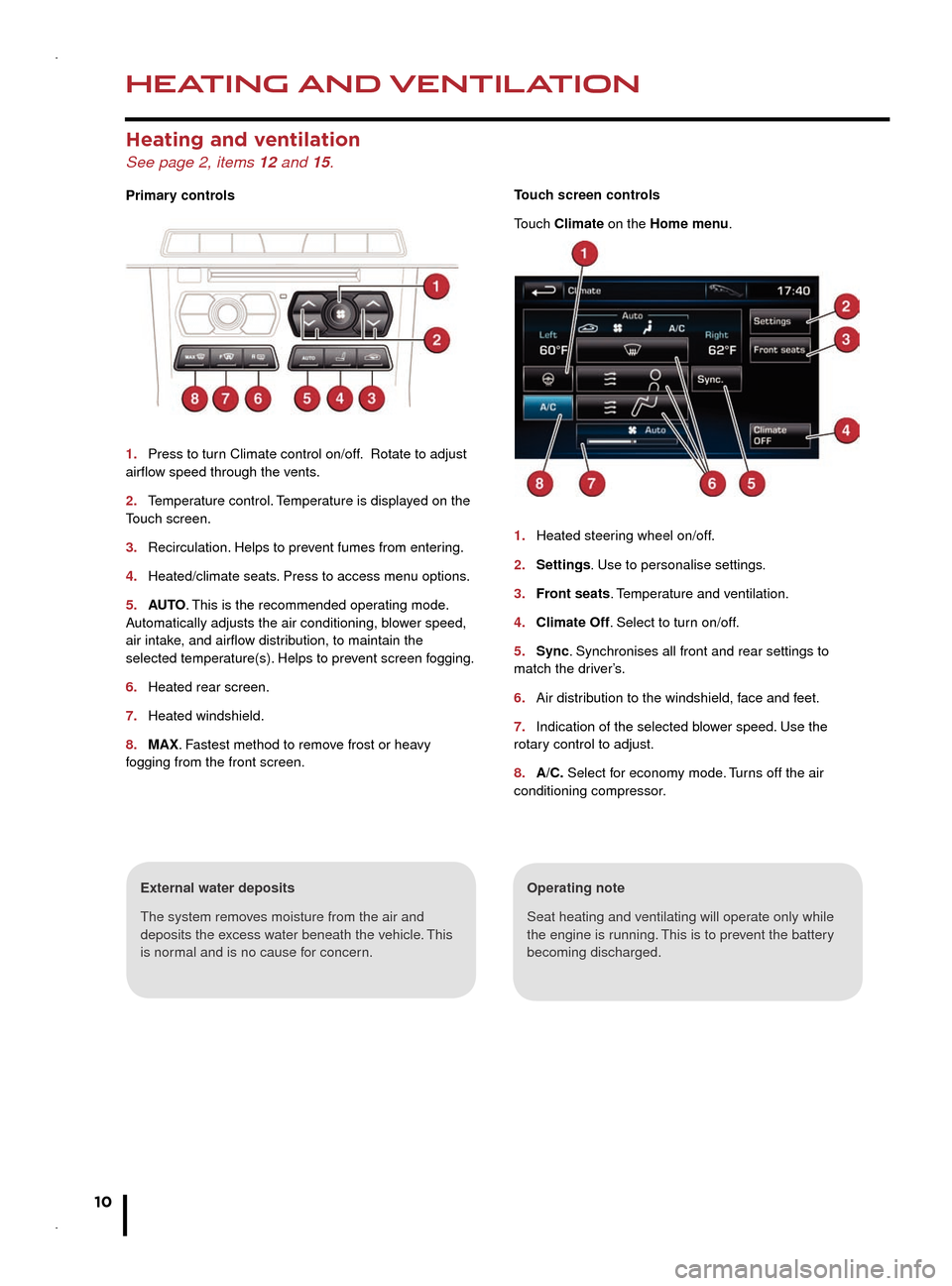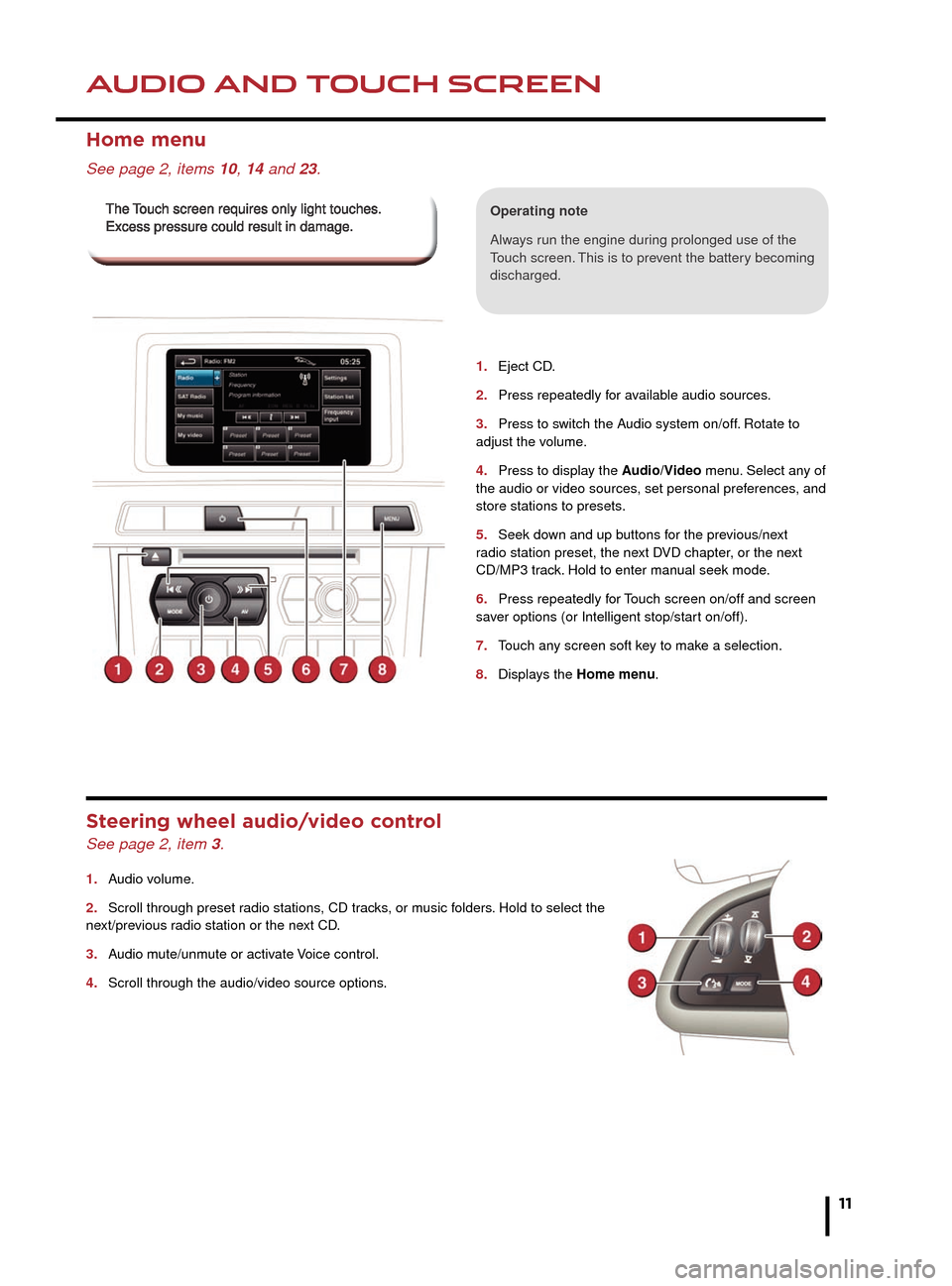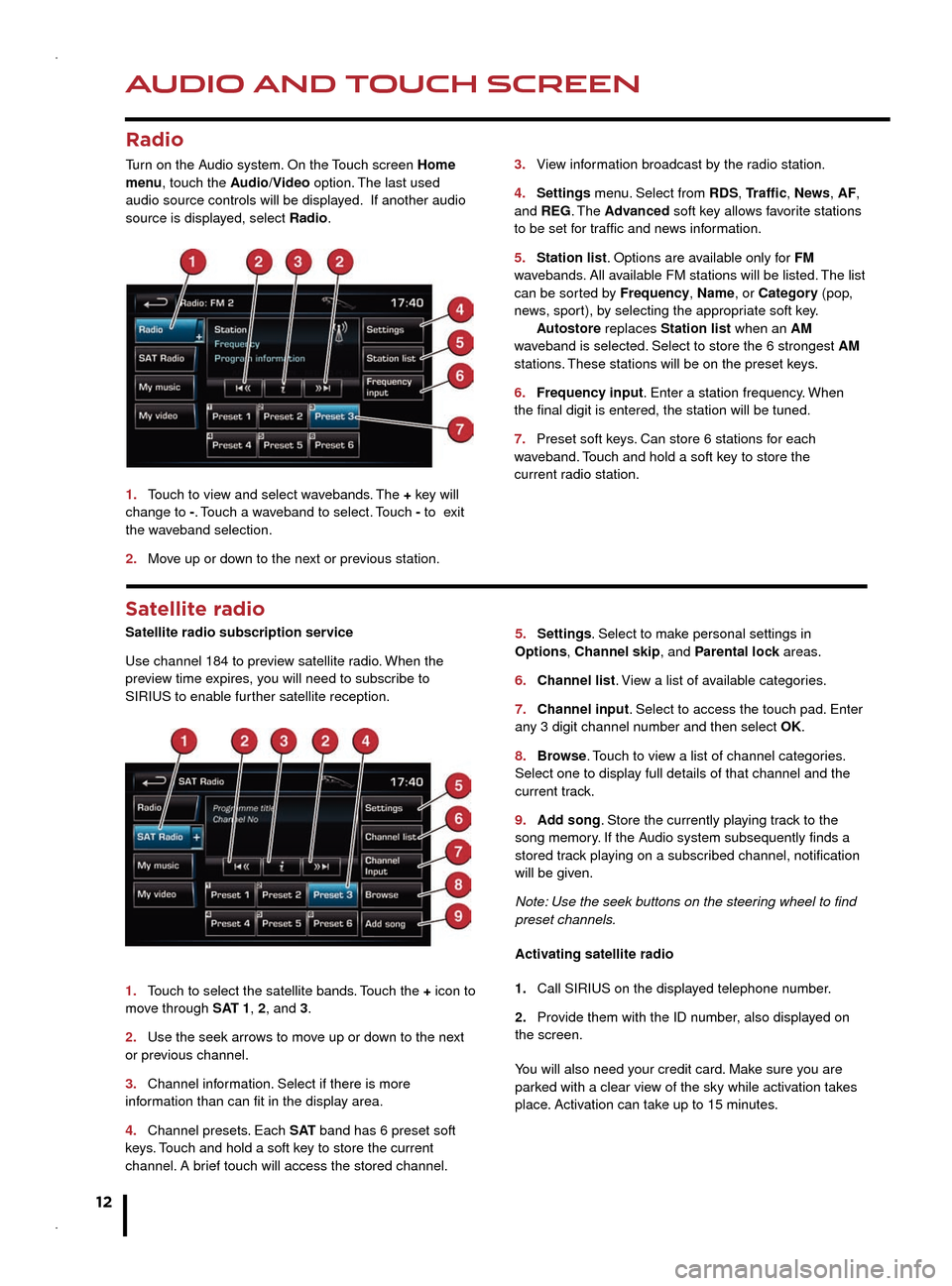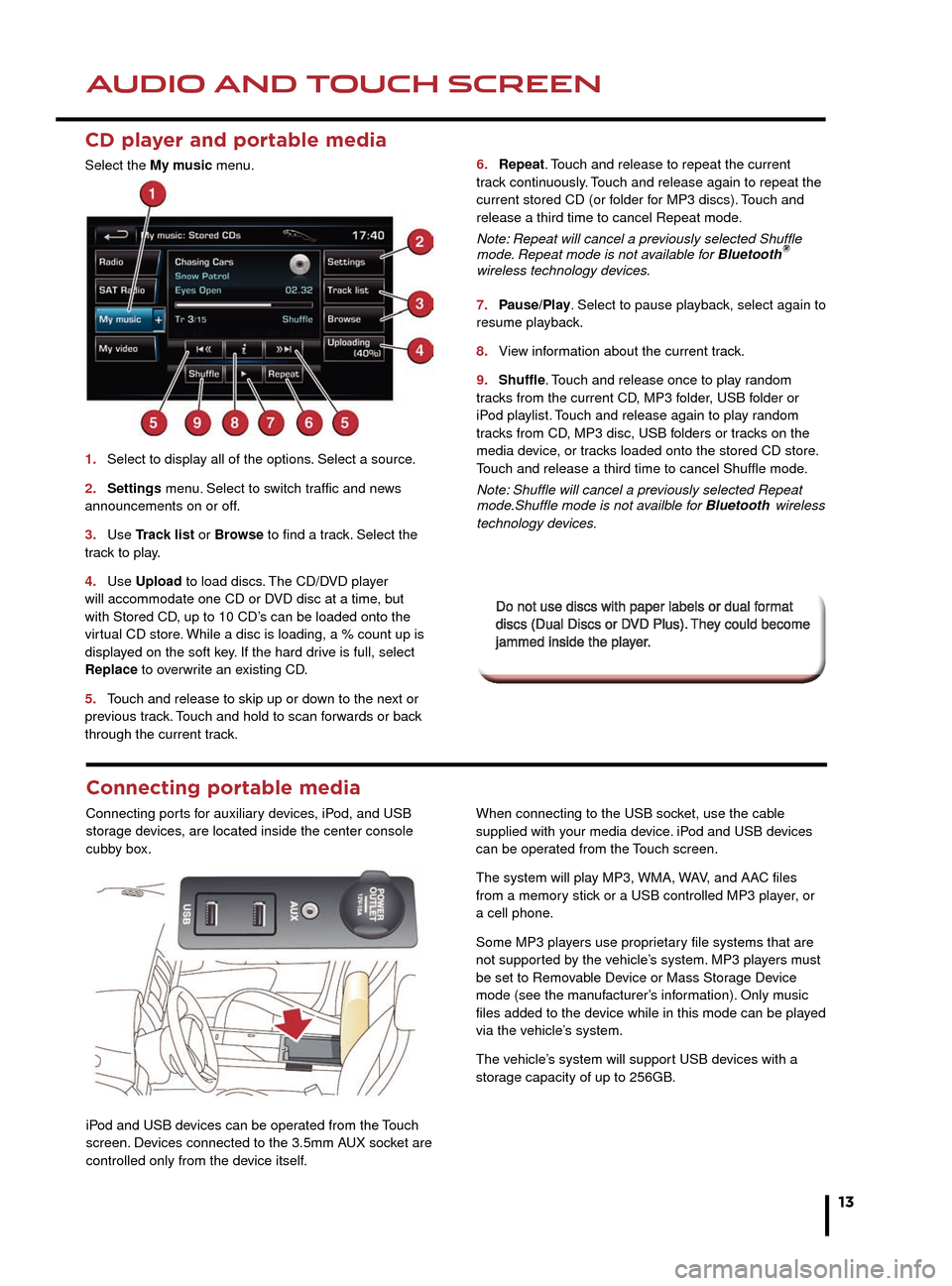2014 JAGUAR XF display
[x] Cancel search: displayPage 4 of 16

COMFORT ADJUSTMENTS
4
STARTING AND DRIVING
Setting the driving position
See page 2, items 25, 30 and 31.
Driver’s seat
Set the seat position using the following controls:
1.
Seatback angle and head restraint.
2.
Lumbar support.
3.
Side bolster - deflate.
4.
Side bolster - inflate.
5.
Cushion length.
6.
Seat forwards and bac
k, cushion height and cushion
angle.
7.
With the vehicle stationary
, adjust the steering wheel
to the required driving position.
Note: Seat heater controls are accessed via the Touch
screen.
Storing the driving position to memory
When the driver’s seat, steering wheel and door mirrors
are adjusted to the required position, the settings can be
stored.
8.
Press the SET b
utton to activate the memory store
function. The button will illuminate to indicate the memory
store function is active.
9.
Press button 1
, or 2 within 5 seconds to store the
current driving position to the chosen number.
Use a stored memory position by pressing the
appropriate button; 1, or 2. The seat, steering wheel and
mirrors will move to their preset positions.
Door mirrors
1. Press the left or right mirror selector.
2. Use the mirror adjuster to set the mirror’s position.
Restraints
Time limit
Memory buttons must be pressed within 5 seconds
after pressing the SET button, otherwise the memory
store function will cancel.
A warning lamp in the Instrument panel will
illuminate if the seat belt of an occupied
front seat is not fastened. This may be
accompanied by an audible warning.
Using child seats
Refer to Child Seat Positioning in the Owner’s
Handbook to determine the correct seat for your child. If it becomes necessary to fit a child restraint on the front
passenger seat, make the following seat adjustments:
• Move the seat fully rearward.
• Adjust the lumbar support to its minimum setting.
• Adjust the seat cushion to its highest position.
• Adjust the cushion front tilt to its lowest position.
• Adjust the seatback to the fully upright position.
• Adjust the upper seat belt anchorage to its lowest
position.
Engine start/stop
See page 2, item 22.
Ignition only on
• With the Smart key inside the vehicle, press the
START/STOP button once to switch on the ignition.
• A second press will switch off the ignition.
Engine start
• The transmission must be in either P or N position to
enable engine starting.
• With the brake pedal depressed, press and release the
START/STOP button to start the engine.
• Press again to stop the engine and switch off the
ignition.
Intelligent stop/start
See page 2, item 9.
The Intelligent stop/start system is automatically activated
when the ignition is turned on. If the vehicle is stopped,
the engine will turn off (unless it is required to support
other vehicle systems). When the brake pedal is released
and a drive gear is selected, the engine will restart
automatically.
A warning lamp in the Instrument panel
will illuminate when the engine has been
switched off by the stop/start system.
Warning lamps
Displayed in the Instrument panel. DO NOT ignore warning lamps.
Page 5 of 16

COMFORT ADJUSTMENTSSTARTING AND DRIVING
5
Rolling start
If the engine is switched off while the vehicle is moving,
it can be restarted after 2 seconds have elapsed. Select
transmission N position and then press the START/STOP
button.
Smart key use
The engine will continue to run, even if the Smart
key is removed from the vehicle. However, if the
engine is stopped, it cannot be restarted until the
Smart key is returned to the vehicle.
Restraints
Time limit
Memory buttons must be pressed within 5 seconds
after pressing the SET button, otherwise the memory
store function will cancel.
If it becomes necessary to fit a child restraint on the front
passenger seat, make the following seat adjustments:
• Move the seat fully rearward.
• Adjust the lumbar support to its minimum setting.
• Adjust the seat cushion to its highest position.
• Adjust the cushion front tilt to its lowest position.
• Adjust the seatback to the fully upright position.
• Adjust the upper seat belt anchorage to its lowest
position.
Engine start/stop
See page 2, item 22.
Ignition only on
• With the Smart key inside the vehicle, press the
START/STOP button once to switch on the ignition.
• A second press will switch off the ignition.
Engine start
• The transmission must be in either P or N position to
enable engine starting.
• With the brake pedal depressed, press and release the
START/STOP button to start the engine.
• Press again to stop the engine and switch off the
ignition.
Intelligent stop/start
See page 2, item 9.
The Intelligent stop/start system is automatically activated
when the ignition is turned on. If the vehicle is stopped,
the engine will turn off (unless it is required to support
other vehicle systems). When the brake pedal is released
and a drive gear is selected, the engine will restart
automatically.
A warning lamp in the Instrument panel
will illuminate when the engine has been
switched off by the stop/start system. To switch Intelligent stop/start off, press the ECO switch.
Note: The engine will restart automatically if the switch is
pressed while an automatic engine stop is in progress.
Warning lamps
Displayed in the Instrument panel. DO NOT ignore warning lamps.
Low tire pressure.
Air bag fault.
Braking system fault or
brake fluid low. Braking system fault or
brake fluid low. USA only. Seat belt reminder.Rear fog lamp on.
Forward alert active.
Adaptive cruise control
active.
Automatic speed limiter
active.
Anti-lock braking system
fault. USA only.
Anti-lock braking system
fault. Dynamic stability control.
Flashes when DSC is
operating.
Engine malfunction.
DSC switched off, TracDSC
on.
Page 7 of 16

STARTING AND DRIVINGSTARTING AND DRIVING
7
Cruise control and Forward alert
Setting Cruise control speed
1. Use to set the cruise speed or to increase/decrease speed while Cruise control is operating.
2. Resumes the set speed after a cancellation.
3. Press to cancel but retain the set speed in memory.
Cruise control will also cancel if the brake pedal is pressed or if the vehicle’s speed falls below 18mph (30 km/h).
Adaptive cruise control (ACC)
This enhancement uses a front mounted radar to monitor traffic ahead. ACC can be programed to maintain a set gap to the vehicle ahead. If the vehicle ahead is traveling slower than the set speed, your vehicle will automatically slow down and then maintain the set gap until the road ahead clears. At that point, your vehicle will accelerate to the set speed.
7
ACC gap setting
4. Press to decrease or increase the set gap to the vehicle ahead.
When ACC is active, an amber warning lamp will illuminate in the Instrument panel. The Message center will display the current set gap. There are 4 gap settings to choose from.
Set speeds are cleared at ignition switch off.
Forward alert
Forward alert is an additional feature of ACC and provides limited detection of objects in the road ahead. When necessary, it will give an audible warning plus the Message center warning FORWARD ALERT. The driver must take appropriate action.
5. Press to activate the Forward alert function.
The Forward alert icon will illuminate in the Instrument panel.
Sensitivity of detection can be adjusted. With ACC disengaged, use the ACC gap setting control 4 to adjust the setting.
5.
6.
7.
Page 8 of 16

STARTING AND DRIVING
8
STARTING AND DRIVING
Automatic speed limiter (ASL)
See page 2, items 18.
ASL allows any speed above 20 mph (32 km/h) to be set as a maximum speed. This is useful in making sure that any given speed limit is not exceeded.
Setting a speed
The setting procedure can be made while the vehicle is stationary.
1.Press the ASL button. An ASL warning lamp illuminates in the speedometer.
2.Use the Cruise control increase and decrease controls to set a speed.The Message center will display the set speed. Adjustment can be made at any time, to suit variable speed limits.
Rear camera and Parking aids
If ASL is suspended due to kick-down acceleration or by pressing the Cruise control CANCEL button, the Message center will display a LIMITERCANCELLEDmessage.
Press the RESUME control to reinstate the ASL set speed. ASL will resume if the vehicle’s speed is below the previously set speed limit.
Door mirrors and Blind spot
monitoring (BSM)
See page 2, items 30 and 31.
Page 10 of 16

HEATING AND VENTILATION
10
AUDIO AND TOUCH SCREEN
Heating and ventilation
See page 2, items 12 and 15.
Primary controls
1. Press to turn Climate control on/off. Rotate to adjust airflow speed through the vents.
2. Temperature control. Temperature is displayed on the Touch screen.
3. Recirculation. Helps to prevent fumes from entering.
4. Heated/climate seats. Press to access menu options.
5. AUTO. This is the recommended operating mode. Automatically adjusts the air conditioning, blower speed, air intake, and airflow distribution, to maintain the selected temperature(s). Helps to prevent screen fogging.
6. Heated rear screen.
7. Heated windshield.
8. MAX. Fastest method to remove frost or heavy fogging from the front screen.
Operating note
Seat heating and ventilating will operate only while the engine is running. This is to prevent the battery becoming discharged.
External water deposits
The system removes moisture from the air and deposits the excess water beneath the vehicle. This is normal and is no cause for concern.
Touch screen controls
Touch Climate on the Homemenu.
1. Heated steering wheel on/off.
2. Settings. Use to personalise settings.
3. Front seats. Temperature and ventilation.
4. Climate Off. Select to turn on/off.
5. Sync. Synchronises all front and rear settings to match the driver’s.
6. Air distribution to the windshield, face and feet.
7. Indication of the selected blower speed. Use the rotary control to adjust.
8. A/C. Select for economy mode. Turns off the air conditioning compressor.
Home menu
See page 2, items 10, 14 and 23.
Steering wheel audio/video control
See page 2, item 3.
1.
2.
3.
4.
Page 11 of 16

HEATING AND VENTILATIONAUDIO AND TOUCH SCREEN
11
1.
2.
3.
4.
5.
6.
7.
8.
1. Eject CD.
2. Press repeatedly for available audio sources.
3. Press to switch the Audio system on/off. Rotate to adjust the volume.
4. Press to display the Audio/Video menu. Select any of the audio or video sources, set personal preferences, and store stations to presets.
5. Seek down and up buttons for the previous/next radio station preset, the next DVD chapter, or the next CD/MP3 track. Hold to enter manual seek mode.
6. Press repeatedly for Touch screen on/off and screen saver options (or Intelligent stop/start on/off).
7. Touch any screen soft key to make a selection.
8. Displays the Home menu.
Home menu
See page 2, items 10, 14 and 23.
Operating note
Always run the engine during prolonged use of the Touch screen. This is to prevent the battery becoming discharged.
Steering wheel audio/video control
See page 2, item 3.
1. Audio volume.
2. Scroll through preset radio stations, CD tracks, or music folders. Hold to select the next/previous radio station or the next CD.
3. Audio mute/unmute or activate Voice control.
4. Scroll through the audio/video source options.
The Touch screen requires only light touches. The Touch screen requires only light touches. Excess pressure could result in damage.Excess pressure could result in damage.
Page 12 of 16

AUDIO AND TOUCH SCREEN
12
AUDIO AND TOUCH SCREEN
CD player and portable media
Select the My music menu.
1. Select to display all of the options. Select a source.
2. Settings menu. Select to switch traffic and news
announcements on or off.
3. Use Track list or Browse to find a track. Select the
track to play.
4. Use Upload to load discs. The CD/DVD player
will accommodate one CD or DVD disc at a time, but
with Stored CD, up to 10 CD’s can be loaded onto the
virtual CD store. While a disc is loading, a % count up is
displayed on the soft key. If the hard drive is full, select
Replace to overwrite an existing CD.
5. Touch and release to skip up or down to the next or
previous track. Touch and hold to scan forwards or back
through the current track.
Satellite radio
Satellite radio subscription service
Use channel 184 to preview satellite radio. When the
preview time expires, you will need to subscribe to
SIRIUS to enable further satellite reception.
1.
Touch to select the satellite bands.
Touch the + icon to
move through SAT 1, 2, and 3.
2.
Use the seek arrows to mov
e up or down to the next
or previous channel.
3.
Channel information.
Select if there is more
information than can fit in the display area.
4.
Channel presets. Each
S AT band has 6 preset soft
keys. Touch and hold a soft key to store the current
channel. A brief touch will access the stored channel. 5. Settings. Select to mak
e personal settings in
Options, Channel skip, and Parental lock areas.
6.
Channel list.
View a list of available categories.
7.
Channel input. Select to access the touch pad.
Enter
any 3 digit channel number and then select OK.
8.
Browse
. Touch to view a list of channel categories.
Select one to display full details of that channel and the
current track.
9.
Add song.
Store the currently playing track to the
song memory. If the Audio system subsequently finds a
stored track playing on a subscribed channel, notification
will be given.
Note: Use the seek buttons on the steering wheel to find
preset channels.
Activating satellite radio
1.
Call SIRIUS on the displayed telephone n
umber.
2.
Provide them with the ID number
, also displayed on
the screen.
You will also need your credit card. Make sure you are
parked with a clear view of the sky while activation takes
place. Activation can take up to 15 minutes.
3.
View infor
mation broadcast by the radio station.
4. Settings menu.
Select from RDS, Traffic, News, AF,
and REG. The Advanced soft key allows favorite stations
to be set for traffic and news information.
5.
Station list. Options are a
vailable only for FM
wavebands. All available FM stations will be listed. The list
can be sorted by Frequency, Name, or Category (pop,
news, sport), by selecting the appropriate soft key.
Autostore replaces
Station list when an AM
waveband is selected. Select to store the 6 strongest AM
stations. These stations will be on the preset keys.
6.
Frequency input.
Enter a station frequency. When
the final digit is entered, the station will be tuned.
7.
Preset soft keys
. Can store 6 stations for each
wav
eband. Touch and hold a soft key to store the
current radio station.
Radio
Turn on the Audio system. On the Touch screen Home
menu, touch the Audio/Video option. The last used
audio source controls will be displayed. If another audio
source is displayed, select Radio.
1.
Touch to view and select w
avebands. The + key will
change to -. Touch a waveband to select. Touch - to exit
the waveband selection.
2.
Move up or do
wn to the next or previous station.
Connecting portable media
Connecting ports for auxiliary devices, iPod, and USB
storage devices, are located inside the center console
cubby box.
iPod and USB devices can be operated from the Touch
screen. Devices connected to the 3.5mm AUX socket are
controlled only from the device itself.
Page 13 of 16

AUDIO AND TOUCH SCREENAUDIO AND TOUCH SCREEN
13
CD player and portable media
Select the My music menu.
1. Select to display all of the options. Select a source.
2. Settings menu. Select to switch traffic and news announcements on or off.
3. Use Track list Track list Tor Browse to find a track. Select the track to play.
4. Use Upload to load discs. The CD/DVD player will accommodate one CD or DVD disc at a time, but with Stored CD, up to 10 CD’s can be loaded onto the virtual CD store. While a disc is loading, a % count up is displayed on the soft key. If the hard drive is full, select Replace to overwrite an existing CD.
5. Touch and release to skip up or down to the next or previous track. Touch and hold to scan forwards or back through the current track.
6. Repeat. Touch and release to repeat the current track continuously. Touch and release again to repeat the current stored CD (or folder for MP3 discs). Touch and release a third time to cancel Repeat mode.
Note: Repeat will cancel a previously selected Shuffle mode. Repeat mode is not available for Bluetooth®Note: Repeat will cancel a previously selected Shuffle ®Note: Repeat will cancel a previously selected Shuffle
wireless technology devices.
7. Pause/Play. Select to pause playback, select again to resume playback.
8. View information about the current track.
9. Shuffle. Touch and release once to play random tracks from the current CD, MP3 folder, USB folder or iPod playlist. Touch and release again to play random tracks from CD, MP3 disc, USB folders or tracks on the media device, or tracks loaded onto the stored CD store.Touch and release a third time to cancel Shuffle mode.
Note: Shuffle will cancel a previously selected Repeat mode.Shuffle mode is not availble for Bluetoothwireless technology devices.
5.
6.
7.
8.
9.
3.
4.
5.
6.
7.
Do not use discs with paper labels or dual format Do not use discs with paper labels or dual format discs (Dual Discs or DVD Plus). They could become discs (Dual Discs or DVD Plus). They could become jammed inside the player. jammed inside the player.
Connecting portable media
Connecting ports for auxiliary devices, iPod, and USB storage devices, are located inside the center console cubby box.
iPod and USB devices can be operated from the Touch screen. Devices connected to the 3.5mm AUX socket are controlled only from the device itself.
When connecting to the USB socket, use the cable supplied with your media device. iPod and USB devices can be operated from the Touch screen.
The system will play MP3, WMA, WAV, and AAC files from a memory stick or a USB controlled MP3 player, or a cell phone.
Some MP3 players use proprietary file systems that are not supported by the vehicle’s system. MP3 players must be set to Removable Device or Mass Storage Device mode (see the manufacturer’s information). Only music files added to the device while in this mode can be played via the vehicle’s system.
The vehicle’s system will support USB devices with a storage capacity of up to 256GB.